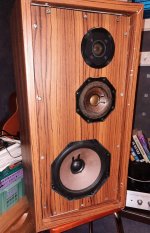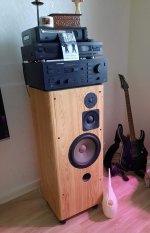Separate boxes for coax and bass? Btw, you need quite a big enclosure for the Peerless. I played around with 100L for one with a 1000uF in series, it reached easily down to 30Hz. I have four of them, PM me if you're interestedThe 12" coax midrange-tweeter must have a small closed subcabin. Twin 12" woofers will use rest of the box.
I have been thinking about SLS12 8R parallel for woofers. https://en.toutlehautparleur.com/speaker-peerless-sls-p830669-8-ohm-12-inch.html
Yes, I know about the high Vas of SLS-12. But I'll be using dsp anyway. They have low Fs, good sensitivity and high enough Xmax. More modern and more expensive (sub)woofers are not needed IMO. TLHP price is 85€.
Visaton W300 is my second choice now, but is the surrond rubber or foam? https://www.visaton.de/en/products/drivers/woofers/w-300-8-ohm
in any case, the woofer choice is easiest and least critical to me. The problem is that there are millions of options!
I'll send you PM!
Visaton W300 is my second choice now, but is the surrond rubber or foam? https://www.visaton.de/en/products/drivers/woofers/w-300-8-ohm
in any case, the woofer choice is easiest and least critical to me. The problem is that there are millions of options!
I'll send you PM!
Last edited:
I built those too, back in the day, -nostalgia! 🙂 I think it was a revised version though, had a mesh over the tweeter (Audax?), same Philips mid, Seas 10" from memory?In another pic we can see my elder son's present speakers, done by me only 40 years ago, also a kit.
View attachment 1120096
This is why I usually shy away from coax drivers using this design with the cone shrouded by the horn. You have to keep the xover very low, well out of cone breakup area. This often means an unacceptably low xover to the HF driver, further negativity impacting system SQ. The larger unsupported horns will also tend to resonate at various frequencies.I did some really crude abec sims to model that gap between the woofer cone and the baffle. Without any treatment you get a big discontinuity. The best result I got was to assume that the gap was filled with felt which would keep the HF out of the gap between the woofer and the waveguide and act as an acoustic low pass filter for the woofer crossover. Easy say; harder to do - have to find a felt thickness that works and a means to keep it in place.
This one looks nice to me.
https://en.toutlehautparleur.com/br...axial-speaker-bms-12c262-8-8-ohm-12-inch.html
https://en.toutlehautparleur.com/br...axial-speaker-bms-12c262-8-8-ohm-12-inch.html
That is the issue. If you can solve these problems/potential problems, you get a better solution because then woofer cone excursion doesn't FM the tweeter and you don't need a separate woofer to relieve the coax of the excursion. If you are going to use woofers in addition to the coax, then you are probably better off with a coax in which the woofer cone serves as a waveguide. We know KEF and SICA make nice small coax's. Its harder to find large coax's with clean top ends, although I agree with Zvu that BMS looks better than most. It really depends on how equalizable that ripple in the HF is and you can't see that without a set of measurements.This is why I usually shy away from coax drivers using this design with the cone shrouded by the horn. You have to keep the xover very low, well out of cone breakup area. This often means an unacceptably low xover to the HF driver, further negativity impacting system SQ. The larger unsupported horns will also tend to resonate at various frequencies.
RCF coaxials are on their way to me already. Let's see how they measure. Home spl should actually be pretty easy task even for 1" CD.
My guess is that a plastic horn has less vibrations than a 12" cone playing music...
I don't know how reliable factory measurements are... RCF is in BR box, BMS in sealed. I expect that 1kHz dip to disappear off-axis. It is obviously interference from the horn, every horn coax has similar, depending of diameter. This RCF has the widest horn I've seen in 12" Audibility??
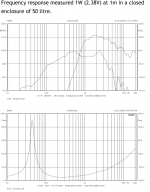
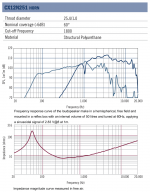
ps. I want to do something different again... I haven't seen a single diy project with these horn coaxes!
My guess is that a plastic horn has less vibrations than a 12" cone playing music...
I don't know how reliable factory measurements are... RCF is in BR box, BMS in sealed. I expect that 1kHz dip to disappear off-axis. It is obviously interference from the horn, every horn coax has similar, depending of diameter. This RCF has the widest horn I've seen in 12" Audibility??


ps. I want to do something different again... I haven't seen a single diy project with these horn coaxes!
Last edited:
^Dsp and active, with Hypex FA123.
I have made two pairs of 3-ways with those already, no problems after I learned the setup with software. DSP makes it very easy to test different xo types, for free. Time alignment and gain adjustment are just as easy. As well as room response tuning. And I am too dumb and lazy to learn modern simulators! I use REW to study measurements, directivity and distortion/resonance figures will be interesting.
https://www.hypex.nl/product/fusionamp-fa123/154
I have made two pairs of 3-ways with those already, no problems after I learned the setup with software. DSP makes it very easy to test different xo types, for free. Time alignment and gain adjustment are just as easy. As well as room response tuning. And I am too dumb and lazy to learn modern simulators! I use REW to study measurements, directivity and distortion/resonance figures will be interesting.
https://www.hypex.nl/product/fusionamp-fa123/154
Endless simulations are not stimulations😱) I'm surprised about the quality of sound of a coax, despite the roughness in treble. Each to their own theories;o)^Dsp and active, with Hypex FA123.
I have made two pairs of 3-ways with those already, no problems after I learned the setup with software. DSP makes it very easy to test different xo types, for free. Time alignment and gain adjustment are just as easy. As well as room response tuning. And I am too dumb and lazy to learn modern simulators! I use REW to study measurements, directivity and distortion/resonance figures will be interesting.
https://www.hypex.nl/product/fusionamp-fa123/154
To clearify, I agree with you about being too dumb and lazy to learn simulators. Also, it's more fun to measure in real time😱)Endless simulations are not stimulations😱) I'm surprised about the quality of sound of a coax, despite the roughness in treble. Each to their own theories;o)
I think that if Tannoy sold his new Dual Concentric like he did before (just the speakers and the xover to assemble to the Diy boxes) he would sell them like "hot bread" ........
Read :
https://www.tannoy.com/innovation/Dual-Concentric-Driver-Technology.html
" Unlike ordinary drive units, Dual Concentric is two drivers physically merged into one. The high frequency unit is positioned on the back of the low frequency driver so that they are effectively on the same axis.
Sound energy is propagated from exactly the same point and delivered through the centre of the low frequency cone- a true point-source. The Dual Concentric delivers a spherical wave front that ensures even dispersion in the horizontal and vertical planes, providing exceptional off-axis performance.
Discrete driver speaker systems using non-coaxial sources have an inherent design flaw in that each drive unit is an acoustic source of its own. While the components are physically aligned on one axis, they are displaced in source and can only be coherent at one specific listening point. When delays are applied to compensate for driver alignment, signals can only be aligned along a narow listening plane on one axis. Even systems with ratatable horns suffer from a significant 'suck-out' in the crossover region, and no amount of DSP processing can correct this phenomenon. The constant directivity characteristic of the Dual Concentric overcomes such time alignment problems "
So I wonder why no other brand launches a coax with the same concept, patent problems perhaps?
I had the opportunity to listen to several of these "vintage" Tannoy Dual Concentric and I don't agree with the criticism you can read here.
https://audionostalgia.co.uk/tannoy-monitor-gold-15-review/
For me they have a great sound stage and they do not lack depth as the reviewer suggests, surely working on the acoustics of the room, I would have a different opinion.
OP:
Sorry OT but some of the earlier comments about the big horn on the RCF CX12N251 speaker with its huge horn almost completely obscuring the cone led me here.....
😉
Read :
https://www.tannoy.com/innovation/Dual-Concentric-Driver-Technology.html
" Unlike ordinary drive units, Dual Concentric is two drivers physically merged into one. The high frequency unit is positioned on the back of the low frequency driver so that they are effectively on the same axis.
Sound energy is propagated from exactly the same point and delivered through the centre of the low frequency cone- a true point-source. The Dual Concentric delivers a spherical wave front that ensures even dispersion in the horizontal and vertical planes, providing exceptional off-axis performance.
Discrete driver speaker systems using non-coaxial sources have an inherent design flaw in that each drive unit is an acoustic source of its own. While the components are physically aligned on one axis, they are displaced in source and can only be coherent at one specific listening point. When delays are applied to compensate for driver alignment, signals can only be aligned along a narow listening plane on one axis. Even systems with ratatable horns suffer from a significant 'suck-out' in the crossover region, and no amount of DSP processing can correct this phenomenon. The constant directivity characteristic of the Dual Concentric overcomes such time alignment problems "
So I wonder why no other brand launches a coax with the same concept, patent problems perhaps?
I had the opportunity to listen to several of these "vintage" Tannoy Dual Concentric and I don't agree with the criticism you can read here.
https://audionostalgia.co.uk/tannoy-monitor-gold-15-review/
For me they have a great sound stage and they do not lack depth as the reviewer suggests, surely working on the acoustics of the room, I would have a different opinion.
OP:
Sorry OT but some of the earlier comments about the big horn on the RCF CX12N251 speaker with its huge horn almost completely obscuring the cone led me here.....
😉
Martion Bullfrog dsp-actives have been ticking in my brain since 2018... 15" coaxial with horn. The sound was very good at audio show, but I haven't seen measurements or review of them. There is a special diffusor in midline.
https://martion.de/speaker/bullfrog/
https://www.testberichte.de/a/lautsprecher/magazin/stereoplay-7-2013/368170.html
But with a poor 12" coax we need a pair of woofers, so it will be a floorstander. Woofers perhaps force cancelling on sides?
https://martion.de/speaker/bullfrog/
https://www.testberichte.de/a/lautsprecher/magazin/stereoplay-7-2013/368170.html
But with a poor 12" coax we need a pair of woofers, so it will be a floorstander. Woofers perhaps force cancelling on sides?
Last edited:
I received the TLHP parcel today and I'll buy four SLS-12 drivers from Peter. I have next week free from work (except for Wed) so I hope to have time to make a simple test box for the coax and start taking measurements for xo. Sensitivity of the CD makes me wonder if I must make a Lpad to avoid noise. I have some leftover resistors for that, values shouldn't be very critical for active setup.
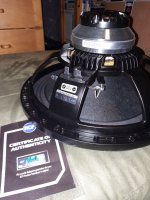
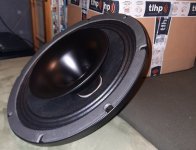
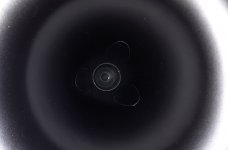
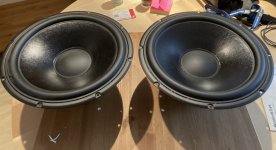




No answer about why the dual concentric design is not copied 😢 ( post 34 ) ....sniff ,....if you see this thread without answer my Tannoy owner friends, your comments will be withering :
" They do not copy it because they are not able to do it that well ! "
And they will add, how do you want that thing similar to a giant whizzer cone to behave well? Lots of turbulence there!
" They do not copy it because they are not able to do it that well ! "
And they will add, how do you want that thing similar to a giant whizzer cone to behave well? Lots of turbulence there!
Attachments
- Home
- Loudspeakers
- Multi-Way
- Big coaxial with RCF CX12N251
